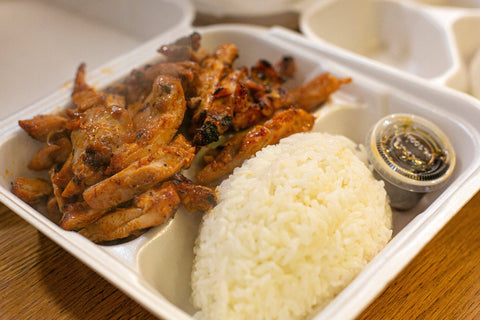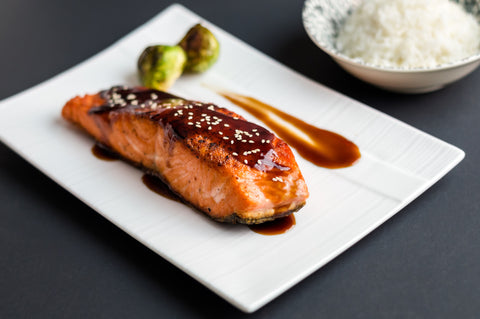
Jump to:
Teriyaki. It's one of the Japanese food words with which many non-Japanese people are familiar.
And yet, when eating Teriyaki in Japan for the first time, many visitors might be surprised as to how different it is from its expatriated cousins.
How did Teriyaki come to mean one thing in Japan and something significantly different in the US and elsewhere? In this edition of the Japanese Taste food blog, we will discover the origins of teriyaki in Japan, and go on a journey to see how this food category has evolved overseas.
The Origins Of Teriyaki In Japan

Teriyaki literally translates as a compound of two words: “shine” and “grill.”
Aficionados of modern teriyaki will recognize this, because its use in the US and around the world is primarily as a glaze for barbecued meats.
But teriyaki's uses and origins in Japan go far beyond simply a glaze for grilling.
Teriyaki came into use in Japanese cuisine two centuries ago. Japan being an island nation and primarily involved in fishing as its main source of protein, a natural preservative was needed to keep the fish available to consume for longer periods of time.
Eventually the sweet, tangy balance of soy sauce, sake and sugar was developed – and teriyaki came to be.
Over time, the use of teriyaki spread beyond fish to other proteins such as chicken, beef and pork. Traditionally, all of these meats and fish were grilled over fire to caramelize the teriyaki sauce, although over time the cooking methods have expanded to stir-fry and other means.
Historically, teriyaki in Japan has been seen as a method of cooking, rather than a bottled sauce. Nor is it something that Japanese people would go out of their way to eat at a restaurant, since it's something that can be made at home with readily available ingredients.
But something happened along the way of Japan's evolution as a society. The Meiji restoration opened Japan up to the world, and that meant not only the importation of foods from abroad, but the export of Japanese food items and methods.
How Teriyaki Was Exported From Japan & Evolved Overseas

The roots of teriyaki outside Japan take place mainly in the United States, both on the mainland and in the islands of Hawaii.
Japanese immigrants to the United States brought with them not so much in terms of material possessions, but very much in the way of cultural and societal traditions. Among these traditions were methods of cooking; and one of those cooking methods was, it turns out, teriyaki.
Encountering a diet that was much more focused on meat, Japanese immigrants were able to use the teriyaki method to make grilled meats quite tastily. Eventually this caught on among people all across US society, thanks in large part to a couple of Japanese immigrants who helped spread the news.
Seattle Teriyaki: Iconic Food Of The Emerald City To This Day

A man named Junki Yoshida owned a grocery store in Seattle, and began selling his bottled teriyaki sauce at the store. It was so popular, in fact, that other stores began to carry the product as well, and eventually the Yoshida teriyaki sauce was a well-known brand name across the Western US.
The Kikkoman company also was involved in bottling Teriyaki sauce, but they probably owe significant thanks to Mr Yoshida as he helped create and expand the booming popularity of teriyaki sauce. Nowadays, Kikkoman teriyaki sauce can be found in supermarket shelves across the US and in many other parts of the world.
Another Japanese immigrant to Seattle, Toshi Kasahara, opened a restaurant in the city's Lower Queen Anne district in 1976. Capitalizing on the popularity of teriyaki sauce, Kasahara decided to use the Teriyaki cooking method on chicken and beef, serving these grilled meats over rice and making these the feature items on his limited but quickly popular menu.
Toshi's Teriyaki opened restaurants across the Seattle and Pacific Northwest area, enjoyed popularity for several decades, and eventually sold all but one location. In the meantime, many competitors emerged as well, as people realized it wasn't too difficult to set up shop using the fairly simple cooking method which had come to be loved in and around Seattle.
A visit today to Seattle (and indeed to the Pacific Northwest region), will greet you with countless Teriyaki shops, mostly of the mom and pop variety, and nearly all serving chicken or beef (and sometimes pork or shrimp) In sauces that largely resemble the original Toshi recipe. Seattle teriyaki sauce often contains ginger and garlic, and the meat is usually marinated for several hours before grilling.
Seattle area residents love to debate where the best teriyaki shop is. And while that issue is not likely to be fully resolved anytime soon – if ever – it certainly is fun making the journey to try them all!
Teriyaki In Hawaii: Plate Lunch & Beyond

Meanwhile, in the islands of Hawaii, Japanese immigrants had also brought Teriyaki and were shaping it into something that would be served to residents and visitors for many decades to come.
The simple recipe of soy sauce, sake and sugar evolved in Hawaii using local ingredients. It is said that Hawaiian Teriyaki often contains pineapple juice and or brown sugar, for example.
Although both teriyaki beef and chicken are available in Hawaii nowadays, chicken was traditionally the primary protein in Hawaiian teriyaki. With somewhat limited farming land available in the state, chicken has historically been a more plentiful protein source for Hawaiians. Of course Teriyaki fish (such as salmon, mahi mahi or even tuna) can be found as well, given the abundant seafood in the area.
Plate lunch is the popular and famous Hawaiian lunch service, and can be found in restaurants, food trucks and food stands across the islands. It is much like a Japanese bento or teishoku. Plate lunch is essentially a container or plate, sectioned off with rice, a protein, and then a salad (often the ubiquitous Hawaiian “mac salad”).
Teriyaki is one of the more popular plate lunch orders in Hawaii, be it teriyaki chicken or teriyaki beef… or even teriyaki fish, tofu and other forms of protein.
Teriyaki Around The World

These days, teriyaki can be found in kitchens and restaurants all around the world.
Both the sauce itself as well as the cooking methods have evolved and vary somewhat from country to country, region to region, etc.
While some countries and cultures have a preference for barbecues and grilling meats, for example, other cultures are more keen on stir-fries and sautés. Especially for people who live in urban areas and don't necessarily have a backyard barbecue available, a teriyaki stir fry or saute makes complete sense.
Meanwhile, the term teriyaki has become somewhat synonymous with the eponymous Japanese sauces found in restaurants in the UK, Europe, Australia and elsewhere.
How To Make Teriyaki At Home

Curious about making teriyaki at home? We've got you covered, with some easy recipes and suggestions as well as a few essential items you can find right here on japanesetaste.com.
Here’s our recipe for Teriyaki chicken:
How to Make Teriyaki Chicken + Homemade Teriyaki Sauce
… as well as articles about mirin and tamari:
6 Best Japanese Mirin You Can Buy Online
Only A Gluten-Free Alternative? Everything You Need to Know About Tamari Sauce
Why not try your hand with some of our food products, such as:
- Ebara Teriyaki no Tare Japanese Teriyaki Sauce
- Mizkan Sozaian Authentic Japanese Teriyaki Sauce
- Kewpie Teriyaki Mayo Japanese Teriyaki Sauce and Mayonnaise
Just as teriyaki has evolved and adapted outside Japan, so too can teriyaki evolve and adapt in your kitchen. Don’t worry about the “rules” or being “authentic,” but rather find what works best for your own tastes and preferences.
Japanese Food Evolution: How Teriyaki Lives On

Teriyaki has become a fairly ubiquitous term in the food cultures not only of Japan but around the world.
In Japan today, Teriyaki is still a well-utilized and respected method of cooking, seen often for fish but sometimes for chicken and other proteins. Meanwhile in many parts of the US and elsewhere globally, teriyaki has become well known as a barbecue glaze as well as a means of grilling or stir frying chicken, beef, pork, shrimp, fish and other proteins, even tofu!
Whether you're enjoying teriyaki in a strip mall in Seattle, on the grill at home, or in a traditional sauce at a Japanese inn, teriyaki will tempt you not only with its flavors but its interesting and intricate history as well.


2 comments
We’re glad you enjoyed learning about teriyaki! Thank you for your comment, and we hope you’ll keep exploring more Japanese cooking techniques to try at home.
Japanese Taste,
The blog explores the origins of teriyaki, a traditional Japanese cooking style characterized by sweet and savory flavors. It highlights how teriyaki has evolved internationally, with variations in sauces and cooking techniques to suit local tastes.
Stellar Homes developers,